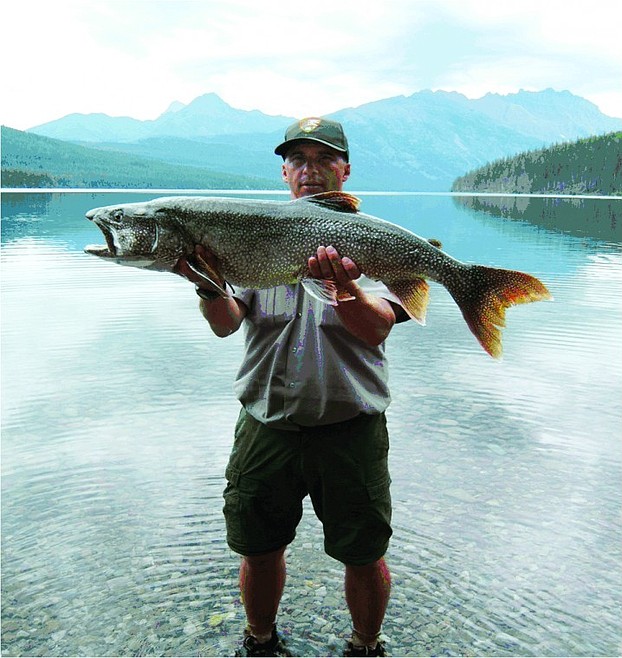Lake-trout tactics paying off
JIM MANNThe Daily Inter Lake | Hagadone News Network | UPDATED 14 years, 3 months AGO
It’s been rough and wearying work plying the waters of Glacier National Park’s remote Quartz Lake for unwanted lake trout, but the effort appears promising so far.
Since the experimental suppression project got under way in 2009, more than 1,500 non-native lake trout have been removed from the lake through spring and fall gill netting.
“All the signs are indicating that we are making a dent up there for sure,” said Clint Muhlfeld, an aquatic research ecologist with the U.S. Geological Survey. “We saw a pretty dramatic decline over the course of the spring sampling.”
Muhlfeld wants to see diminishing returns in the nets during the five-week spring netting, which takes a more random approach to the lake than targeted fall netting.
This year, getting into the lake was challenging because of persistent snow and high water on streams that prevented the use of livestock to get equipment to the lake. Muhlfeld’s crew had to backpack nets, supplies and gas for a boat that is being used for the project.
But fall netting can be even tougher because the crew works in foul weather for several weeks from mid-October to early November, the peak lake trout spawning period.
“They live at the Quartz Cabin,” Muhlfeld said of his three-man crew. “They are like professional commercial fishermen at this point. It’s difficult working in such harsh weather conditions in such a remote setting.”
But the fall netting is the most effective in removing adult lake trout because lake trout tagged with radio transmitters — called “Judas fish” — have led the crew to well-defined spawning areas.
“We’re using the Judas fish to lead us to the spawning areas and then we net using larger-sized mesh in those areas, primarily at night,” Muhlfeld said. “We found two main areas where they spawn at the base of two avalanche chutes on the north side of the lake.”
Even with diminishing catches of lake trout, the netting project likely will carry on for a couple of years because of a lag effect in which remaining young lake trout will become spawners, Muhlfeld said.
Quartz Lake was selected for the experimental project for a variety of reasons, but the most important is that the lake trout invasion from the Flathead River system is relatively new and the lake still has a healthy component of native westslope cutthroat and bull trout, which are listed as a threatened species.
“I think protecting the best of what you have left first is a pretty sound way of looking at things,” said Chris Downs, the park’s fisheries manager.
The lake also is mostly protected from future lake trout invasion because of a fish barrier that was installed downstream from Lower Quartz Lake in 2004. But when lake trout were detected afterwards, the barrier project was not completed.
There is currently a proposal to finish the project with improvements aimed at beefing up the barrier to ensure that lake trout and other non-native species cannot get past it.
“Now with implementation of an experimental suppression program, it makes sense to carry that barrier project forward to completion,” Downs said.
The project is considered important because native cutthroat and bull trout are considered imperiled in most of the park’s 17 west-side lakes, precisely because of non-native fish invasions.
Nine of the lakes have been invaded by lake trout and one by brook trout, with obvious impacts on the native species.
“If you look at our localized populations, we’re losing them,” Muhlfeld said of bull and cutthroat trout that spend their entire lives in the park lakes but are still an important part of the broader Flathead Lake and river systems.
“We want to preserve all pieces of the puzzle because it will allow the greater Flathead Lake metapopulations to persist over time,” he said.
Muhlfeld stresses that the invaded lakes in Glacier Park have now become source populations for lake trout “steppingstone invasions” into other waters.
“They go everywhere. They’re extremely effective invaders. With interconnected lake and river systems they tend to pioneer new areas,” Muhlfeld said. “Lake trout are by far the number one threat to bull trout in the system right now.”
But lake trout suppression projects can be long and costly endeavors.
One has been under way for years on Yellowstone Lake in Yellowstone National Park. There have been similar netting efforts on Idaho’s Priest Lake and Lake Pend Oreille.
Most recently, there has been a project on Montana’s Swan Lake, but that effort came too late to stop lake trout from proliferating through the Swan River into Lindbergh Lake.
Muhlfeld believes the Quartz Lake project will be more successful than other efforts because of the fish barrier and the simplicity of the lake’s bathtub-like structure.
The results of the project will be evaluated and could be applied to other park waters such as Logging Lake.
“We are taking it one step at a time,” Downs said. “At this point we’re trying to see what works and what doesn’t work.”
Reporter Jim Mann may be reached at 758-4407 or by email at [email protected].
ARTICLES BY JIM MANNTHE DAILY INTER LAKE
Evergreen man gets five years for death
David Day, 55, was sentenced Wednesday for negligent homicide related to the death of another man at Day’s Evergreen apartment last June.
'Moderate majority' makes a difference
The 2013 Legislature concluded last week with general satisfaction among several Flathead Valley lawmakers, but also disappointments
Canadians help boost Blacktail to record season
Blacktail Mountain Ski Area finished off its winter season with a new record for skier visits and revenue, which is partly being attributed increased Canadian visitation.

